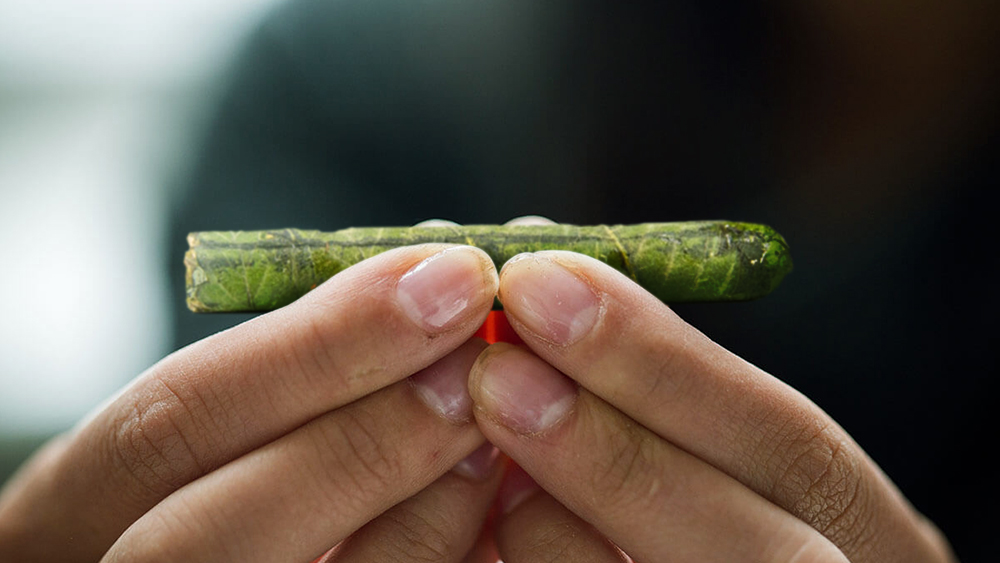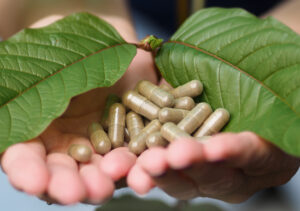There are many ways to smoke marijuana. You can use a pipe, bong, or roll it into a joint. Yet for those of you looking for a more exotic way to smoke your weed, there’s something called a Thai stick.
You probably haven’t heard of this before as it isn’t as well known as some other more popular methods for consuming cannabis.
In fact, many people think that “Thai stick” refers to the tantalizing Thai sativa landrace strain that grows natively on the hills of Northern Thailand – and that part is true.
The high-potency sativa strains that are used to make a Thai stick do, indeed, originate from Thailand. However, there’s more to the story than that.
Let’s take a deeper look at this legendary blunt and, if you’re curious enough, how to make Thai stick yourself.
What is Thai stick?
The original term, Thai stick (also known as Buddha stick), refers to a unique method of creating a sativa blunt by skewering seedless marijuana buds on a stem and wrapping it with marijuana threads. After that, the blunt is dipped in cannabis oil for an added boost in potency.
The final product is an extra-large blunt that’s made completely out of a cannabis plant. This legendary “ganja” has a distinctive camphor-like aroma with a hint of cinnamon and an uplifting euphoric effect that’s common to the Thai landrace sativa strain.
Fun fact: Although it is believed that the term ganja has Jamaican origins, it is, in fact, a Hindy and Nepali name for “marijuana flower,” and a commonly used term in India, Thailand, and other countries of Southeast Asia.
Later on, the process of making a Thai stick was simplified with bamboo sticks replacing the marijuana stem, and hemp strings replacing the cannabis fibers.
Where does Thai Stick come from?
We should start by mentioning that Marijuana has a long history of recorded use in Thai culture.
People in Thailand cultivated marijuana in their gardens and often used it as medicine for various illnesses, fiber for clothing, and even spice in traditional Thai cuisine (e.g. it is still used as one of the main ingredients in traditional Thai boat noodle soup).
Thai sticks gained popularity in the late ’60s and early 70’s when they were first introduced to western society (the United States, to be precise).
The cause for this occurrence is accredited to American soldiers who were sent to Thailand during the Vietnam War. At the highest peak of the war, around 50,000 American soldiers were stationed in the US military bases in Thailand.
During their deployment, soldiers developed not only a taste but also a need for drugs in Vietnam with cannabis being high on the list. These blunts were stronger than any other cannabis strain available in Western countries.
In fact, Thai sticks were so strong that rumors quickly spread that these sticks were heavily laced with opium. Although never proven, this could easily be true.
The mountainous borderland of Burma, Laos, and Thailand is known as the infamous Golden Triangle, a geographical area that has been the largest opium-producing region of the 20th century.
It was in these Southeast Asian countries where opium and heroin abuse reached epidemic proportions during the 70s.
Thus, when these American soldiers returned to the US, they shared stories about the amazingly strong, but strange-looking, weed cigars they had smoked in Thailand, even bringing back samples of Thai sticks home to prove it.
Demand for Thai sticks sky-rocketed, which opened new channels of drug trade routes for Thailand’s most famous “export.”
What people tend to forget is that back in the ‘70s, there was little to no domestic marijuana production in the US. Consequently, most of the “goods” were imported (read: smuggled) from South America and Southeast Asia.
In the book Thai Stick: Surfers, Scammers, and the Untold Story of the Marijuana Trade, Peter Maguire and ex-smuggler Mike Ritter recorded stories of people who had been involved in the Thai marijuana trade from Thailand to the United States, and to some extent made an impact on marijuana history.
In it, they depict how young surfers, driven by the “peace and love” ideology of the times, became the first Thai stick smugglers. Before they knew it, they were earning big money as Thai sticks became the most expensive marijuana sold in the world.
Thai sticks were vastly superior to any other cannabis available on the market that people were ready to pay 10 times more just to get their hands on this exotic product.
According to Peter McQuire, what smugglers would buy for three dollars a kilo on a farm in Thailand could easily reach up to $4,000 on the streets in the United States.
High Times, a definitive resource magazine for cannabis established in 1974, wrote:
“Who can forget the first strange-looking Thai Sticks a decade ago! Dense, seedless, stronger than a bull elephant. Years before sophisticated sinsemilla techniques were incorporated into the crop management of U.S. growers…”
How do you make a Thai stick?
Warning: Before you get yourself into the process of making a Thai stick, you should know that this is not an easy blunt to make and it’s going to take practice, determination, and a lot of patience. Making Thai sticks may seem like a lot of work, but if you do it correctly, you may be surprised by the sensational high you’re going to experience.
What you’ll need:
- Weed buds. It would be nice if you could use Thai sativa strains to keep this blunt completely traditional and preserve what’s supposed to be the original taste, but any marijuana strain will do. As long as it’s not too dense, you’re good to go.
- Bamboo stick. Alternatively, you can use kebab stick or chopstick.
- Cannabis oil or sugar water. You probably know by now that cannabis oil will increase the potency of this blunt, so choose carefully. If you’re using no-high CBD oil, then no need to worry.
- Hemp string.
- Cannabis leaves of a growing marijuana plant. This can be hard to find. Some producers suggest using tobacco leaf as a substitute, but I wouldn’t recommend it. The taste just won’t be the same, and technically, it’s not a Thai stick if it’s not made completely out of marijuana plant.
- Parchment paper.
A step-by-step guide to making Thai sticks
- Take the stick and paint it with a layer of cannabis oil or sugar water.
- When the stick is sticky enough, it’s time to glue your buds to it. Carefully press the buds onto a skewer and make sure there are no blank spaces in between them. Then wrap it up with hemp strings.
- Now wrap the tied buds into parchment paper and put it in a refrigerator for 24-48 hours (the longer the better). This is necessary for weed to fuse into one piece.
- After you waited patiently, here comes the moment of truth. Carefully unwrap the hemp string from the buds and hope that buds don’t fall off the stick. If this is the case, then you’re doing it right and you may proceed further. If not, go back to step one.
- Now it’s time for another glaze of cannabis oil (or sugar water) so you can wrap the whole blunt into cannabis leaves (or, the unpopular option of tobacco leaves).
- Then comes another wrapping job with cannabis string and freezing time of at least 48 hours. You need to repeat this process 2 more times because at least 3 layers of cannabis leaves are necessary to keep your Thai stick fused.
If you don’t want to wait for three days, you can apply all three layers of cannabis leaves at once. Just use cannabis oil (or sugar water) in between layers to stick everything together.
- When you’ve applied all your leafy layers onto your stick, wrap it in the parchment paper and heat it on a pan for a couple of seconds. The cannabis oil will heat up and tie the leaves to the stick.
- The final step is similar to the ones before where you have to rewrap the stick into cannabis string and place it in the refrigerator for at least one, but preferably two, more days. This is called the curing process.
The curing process will remove moisture from the cannabis, further bend all the layers of cannabis leaves into one homogenous unit and most importantly, enhance the flavor.
Some suggest to put Thai sticks in a plastic bag and bury it three feet underground for one month. This traditional curing process will give the optimal potency and taste that is typical for a Thai stick.
But if this method seems a bit extreme to you, the other option is to vacuum seal your Thai sticks and wait for one week. The longer you wait, the better the taste and smell will be.
- After you’ve waited somewhere between three to 30 days (it’s up to you to decide how much time you’re prepared to wait, but bear in mind that the longer you wait, the sweeter the reward), it’s time to try your handmade Thai stick.
Just don’t forget to remove the hemp string and the stick from the blunt before you smoke it. You’re ready to go.
If you managed to make your own Thai stick, please share your experience in the comment section below. We’d love to hear your story!






Mark Schwartz July 11, 2020 at 8:30 pm
My first hand experiences with Thai sticks in the high end New York City market from 1982-1985 are different from your description. To the best of my knowledge, traditional Thai sticks were never meant to be smoked as a cigarette or cigar is smoked. They are a means of bundling, packaging, selling, and exporting premium cannabis flowers in a region where hashish is the usual preferred form. As far as I know, pulling out the stick and smoking one is the invention of an American cannabis producer for the dispensary market. Also, I have never seen a real Thai stick covered in leaves, dipped in sugar water(eeeks no don't smoke that shit!), or cured in a freezer(in the middle of a Thai cannabis field?). One buys a Thai stick, breaks some pieces of flower off of the central stick and smokes it in a bowl or rolls a joint with the broken up flower minus any left over thread(usually red or black or red and black). I have personally seen Thai sticks both uncoated as well as coated in a black Rick Simpson-like hash oil that forms a dried, somewhat hardened coating over the threaded buds. And once, in 1982, I came across a stick that had been soaked in raw opium and dried which did not result in a black coating as the hash oil did, but instead just looked like super dense jet black buds beneath the red and black threads. I would love to discover some definitive first hand descriptions of Thai sticks being smoked like blunts in Thailand in the 1970s or 80s if that was done as proposed by this article. If you want respect as a cannabis writer, you really should avoid cutting and pasting from the website of a company that manufactures modern day blunts they call sticks of some sort.
BC September 30, 2020 at 7:59 am
I agree completely. My experience is late 70s New Zealand though. My mind boggles at the thought of smoking an entire Thai stick! You’d need a party of 100 people to pass it around. And they’d all be wasted afterwards.
bernadette planting October 6, 2020 at 2:45 pm
Yes....we never smoked them! We cut up tiny pieces with special scissors and rolled "pinners" (super skinny joints 😂) to smoke!
Mike Barney August 26, 2021 at 1:12 am
I smoked it while I was over there. We called it Buddha. The reason I landed up here, wondering if there was a difference between Thai stick and Buddha. Some day Thai stick was just that and that Buddha was the same thing but cured in opium. But the way the opium was estimated to be 85 to 95% clean for about 10 bucks a gram. We usually wicked a little tobacco out of a cigarette put a third of gram in the cigarette and shake it down. Then the 3 of us would smoke it like a joint. Man you could nod or trip. Anyway if anyone knows for sure or Buddha meant treated and Thai meant clean leave a comment.
Mike Barney August 26, 2021 at 1:20 am
I smoked it while I was over there. We called it Buddha. The reason I landed up here, wondering if there was a difference between Thai stick and Buddha. Some day Thai stick was just that and that Buddha was the same thing but cured in opium. But the way the opium was estimated to be 85 to 95% clean for about 10 bucks a gram. We usually wicked a little tobacco out of a cigarette put a third of gram in the cigarette and shake it down. Then the 3 of us would smoke it like a joint. Man you could nod or trip. Anyway if anyone knows for sure or Buddha meant treated and Thai meant clean leave a comment. By the way I mailed some home and told the girl to cut it up and smoke it in a hash pipe. She didn't believe and she and 7 of her friends rolled a half stuck in a joint they were shit faced the rest of the night. 6 or 7 hours. I remember a corpsman friend said he couldn't wait to get back since you don't get the munchies on that you just get fk'd up. It was 15 bucks for a8 inch stick.